Grace Gao
Stanford University
Satellite Autonomous Clock Fault Monitoring with Inter-Satellite Ranges Using Euclidean Distance Matrices
May 02, 2025Abstract:To address the need for robust positioning, navigation, and timing services in lunar environments, this paper proposes a novel onboard clock phase jump detection framework for satellite constellations using range measurements obtained from dual one-way inter-satellite links. Our approach leverages vertex redundantly rigid graphs to detect faults without relying on prior knowledge of satellite positions or clock biases, providing flexibility for lunar satellite networks with diverse satellite types and operators. We model satellite constellations as graphs, where satellites are vertices and inter-satellite links are edges. The proposed algorithm detects and identifies satellites with clock jumps by monitoring the singular values of the geometric-centered Euclidean distance matrix (GCEDM) of 5-clique sub-graphs. The proposed method is validated through simulations of a GPS constellation and a notional constellation around the Moon, demonstrating its effectiveness in various configurations.
Large-Scale GNSS Spreading Code Optimization
Oct 06, 2024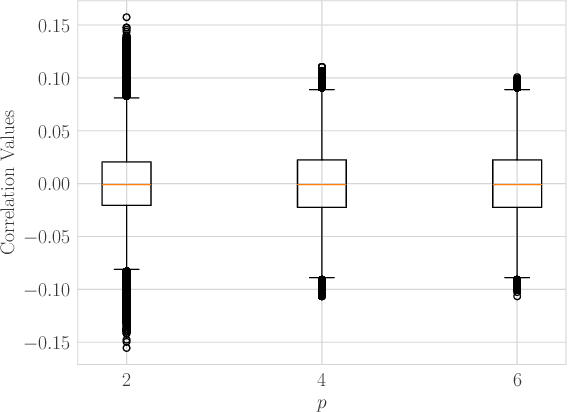

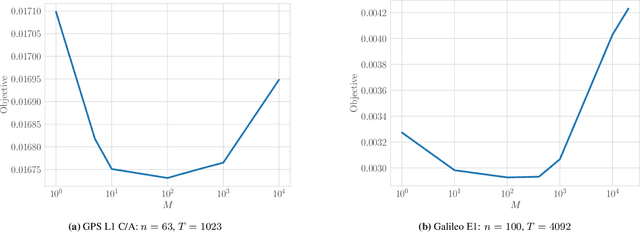

Abstract:We propose a bit-flip descent method for optimizing binary spreading codes with large family sizes and long lengths, addressing the challenges of large-scale code design in GNSS and emerging PNT applications. The method iteratively flips code bits to improve the codes' auto- and cross-correlation properties. In our proposed method, bits are selected by sampling a small set of candidate bits and choosing the one that offers the best improvement in performance. The method leverages the fact that incremental impact of a bit flip on the auto- and cross-correlation may be efficiently computed without recalculating the entire function. We apply this method to two code design problems modeled after the GPS L1 C/A and Galileo E1 codes, demonstrating rapid convergence to low-correlation codes. The proposed approach offers a powerful tool for developing spreading codes that meet the demanding requirements of modern and future satellite navigation systems.
Multi-Robot Collaborative Localization and Planning with Inter-Ranging
Jun 24, 2024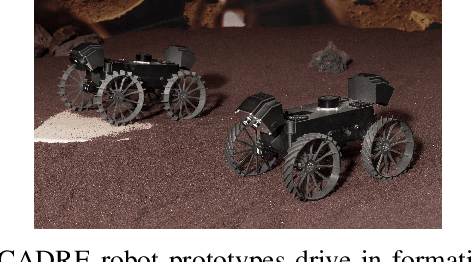
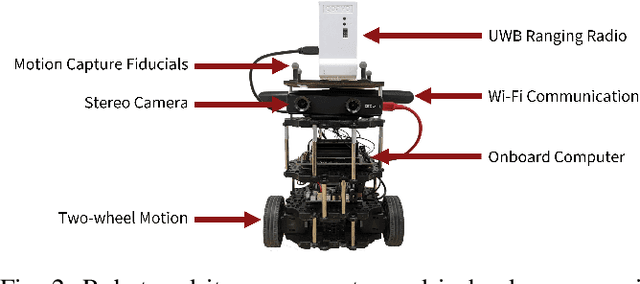
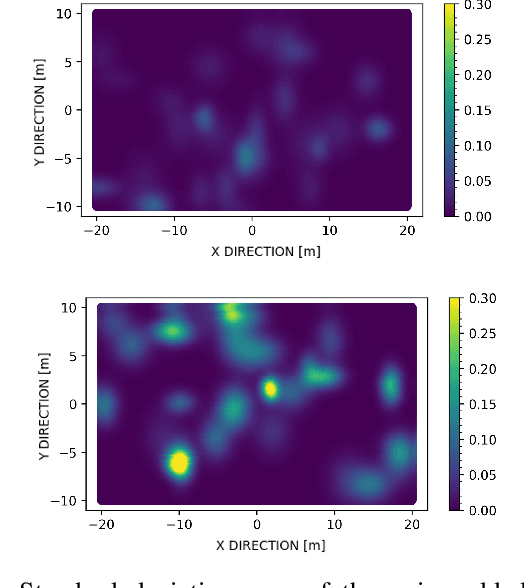
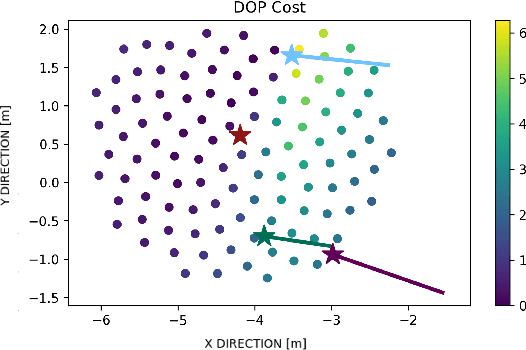
Abstract:Robots often use feature-based image tracking to identify their position in their surrounding environment; however, feature-based image tracking is prone to errors in low-textured and poorly lit environments. Specifically, we investigate a scenario where robots are tasked with exploring the surface of the Moon and are required to have an accurate estimate of their position to be able to correctly geotag scientific measurements. To reduce localization error, we complement traditional feature-based image tracking with ultra-wideband (UWB) distance measurements between the robots. The robots use an advanced mesh-ranging protocol that allows them to continuously share distance measurements amongst each other rather than relying on the common "anchor" and "tag" UWB architecture. We develop a decentralized multi-robot coordination algorithm that actively plans paths based on measurement line-of-sight vectors amongst all robots to minimize collective localization error. We then demonstrate the emergent behavior of the proposed multi-robot coordination algorithm both in simulation and hardware to lower a geometry-based uncertainty metric and reduce localization error.
Autonomous Constellation Fault Monitoring with Inter-satellite Links: A Rigidity-Based Approach
Jun 14, 2024Abstract:To address the need for robust positioning, navigation, and timing services in lunar and Martian environments, this paper proposes a novel fault detection framework for satellite constellations using inter-satellite ranging (ISR). Traditional fault monitoring methods rely on intense monitoring from ground-based stations, which are impractical for lunar and Martian missions due to cost constraints. Our approach leverages graph-rigidity theory to detect faults without relying on precise ephemeris. We model satellite constellations as graphs where satellites are vertices and inter-satellite links are edges. By analyzing the Euclidean Distance Matrix (EDM) derived from ISR measurements, we identify faults through the singular values of the geometric-centered EDM (GCEDM). A neural network predictor is employed to handle the diverse geometry of the graph, enhancing fault detection robustness. The proposed method is validated through simulations of constellations around Mars and the Moon, demonstrating its effectiveness in various configurations. This research contributes to the reliable operation of satellite constellations for future lunar and Martian exploration missions.
Neural Elevation Models for Terrain Mapping and Path Planning
May 24, 2024Abstract:This work introduces Neural Elevations Models (NEMos), which adapt Neural Radiance Fields to a 2.5D continuous and differentiable terrain model. In contrast to traditional terrain representations such as digital elevation models, NEMos can be readily generated from imagery, a low-cost data source, and provide a lightweight representation of terrain through an implicit continuous and differentiable height field. We propose a novel method for jointly training a height field and radiance field within a NeRF framework, leveraging quantile regression. Additionally, we introduce a path planning algorithm that performs gradient-based optimization of a continuous cost function for minimizing distance, slope changes, and control effort, enabled by differentiability of the height field. We perform experiments on simulated and real-world terrain imagery, demonstrating NEMos ability to generate high-quality reconstructions and produce smoother paths compared to discrete path planning methods. Future work will explore the incorporation of features and semantics into the height field, creating a generalized terrain model.
Greedy Detection and Exclusion of Multiple Faults using Euclidean Distance Matrices
Apr 19, 2024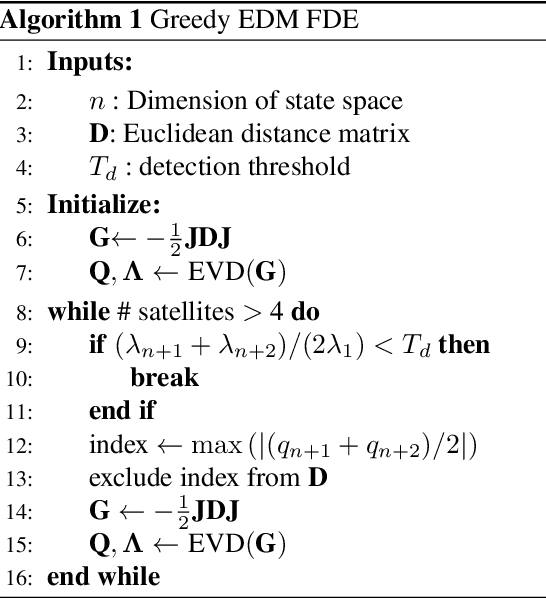
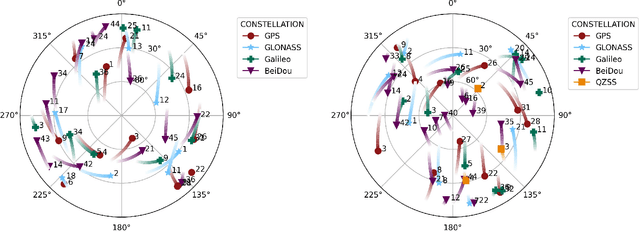
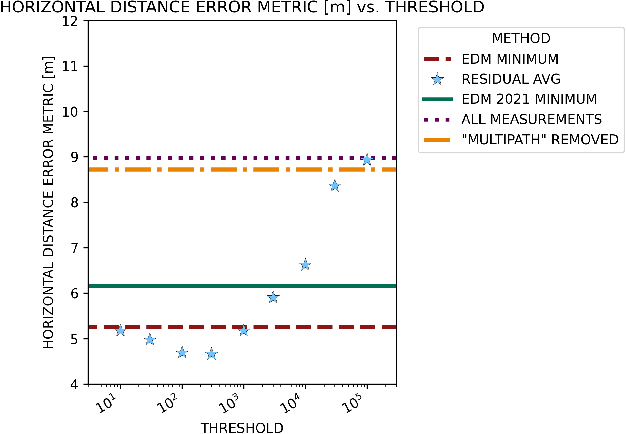
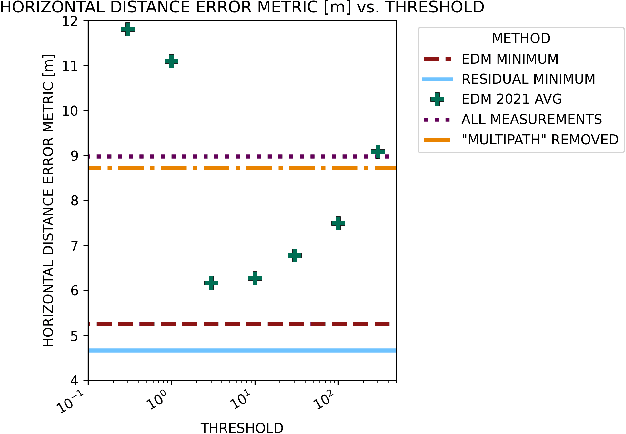
Abstract:Numerous methods have been proposed for global navigation satellite system (GNSS) receivers to detect faulty GNSS signals. One such fault detection and exclusion (FDE) method is based on the mathematical concept of Euclidean distance matrices (EDMs). This paper outlines a greedy approach that uses an improved Euclidean distance matrix-based fault detection and exclusion algorithm. The novel greedy EDM FDE method implements a new fault detection test statistic and fault exclusion strategy that drastically simplifies the complexity of the algorithm over previous work. To validate the novel greedy EDM FDE algorithm, we created a simulated dataset using receiver locations from around the globe. The simulated dataset allows us to verify our results on 2,601 different satellite geometries. Additionally, we tested the greedy EDM FDE algorithm using a real-world dataset from seven different android phones. Across both the simulated and real-world datasets, the Python implementation of the greedy EDM FDE algorithm is shown to be computed an order of magnitude more rapidly than a comparable greedy residual FDE method while obtaining similar fault exclusion accuracy. We provide discussion on the comparative time complexities of greedy EDM FDE, greedy residual FDE, and solution separation. We also explain potential modifications to greedy residual FDE that can be added to alter performance characteristics.
Spreading Code Optimization for Low-Earth Orbit Satellites via Mixed-Integer Convex Programming
Apr 19, 2024Abstract:Optimizing the correlation properties of spreading codes is critical for minimizing inter-channel interference in satellite navigation systems. By improving the codes' correlation sidelobes, we can enhance navigation performance while minimizing the required spreading code lengths. In the case of low earth orbit (LEO) satellite navigation, shorter code lengths (on the order of a hundred) are preferred due to their ability to achieve fast signal acquisition. Additionally, the relatively high signal-to-noise ratio (SNR) in LEO systems reduces the need for longer spreading codes to mitigate inter-channel interference. In this work, we propose a two-stage block coordinate descent (BCD) method which optimizes the codes' correlation properties while enforcing the autocorrelation sidelobe zero (ACZ) property. In each iteration of the BCD method, we solve a mixed-integer convex program (MICP) over a block of 25 binary variables. Our method is applicable to spreading code families of arbitrary sizes and lengths, and we demonstrate its effectiveness for a problem with 66 length-127 codes and a problem with 130 length-257 codes.
gnss_lib_py: Analyzing GNSS Data with Python
Apr 12, 2024



Abstract:This paper presents gnss_lib_py, a Python library used to parse, analyze, and visualize data from a variety of GNSS (Global Navigation Satellite Systems) data sources. The gnss_lib_py library's ease of use, modular capabilities, testing coverage, and extensive documentation make it an attractive tool not only for scientific and industry users wanting a quick, out-of-the-box solution but also for advanced GNSS users developing new GNSS algorithms. gnss_lib_py has already demonstrated its usefulness and impact through presentation in academic conferences, use in research papers, and adoption in graduate-level university course curricula.
Spoofing-Resilient LiDAR-GPS Factor Graph Localization with Chimera Authentication
Jul 10, 2023



Abstract:Many vehicle platforms typically use sensors such as LiDAR or camera for locally-referenced navigation with GPS for globally-referenced navigation. However, due to the unencrypted nature of GPS signals, all civilian users are vulner-able to spoofing attacks, where a malicious spoofer broadcasts fabricated signals and causes the user to track a false position fix. To protect against such GPS spoofing attacks, Chips-Message Robust Authentication (Chimera) has been developed and will be tested on the Navigation Technology Satellite 3 (NTS-3) satellite being launched later this year. However, Chimera authentication is not continuously available and may not provide sufficient protection for vehicles which rely on more frequent GPS measurements. In this paper, we propose a factor graph-based state estimation framework which integrates LiDAR and GPS while simultaneously detecting and mitigating spoofing attacks experienced between consecutive Chimera authentications. Our proposed framework combines GPS pseudorange measurements with LiDAR odometry to provide a robust navigation solution. A chi-squared detector, based on pseudorange residuals, is used to detect and mitigate any potential GPS spoofing attacks. We evaluate our method using real-world LiDAR data from the KITTI dataset and simulated GPS measurements, both nominal and with spoofing. Across multiple trajectories and Monte Carlo runs, our method consistently achieves position errors under 5 m during nominal conditions, and successfully bounds positioning error to within odometry drift levels during spoofed conditions.
A Deep Reinforcement Learning Approach to Rare Event Estimation
Nov 22, 2022



Abstract:An important step in the design of autonomous systems is to evaluate the probability that a failure will occur. In safety-critical domains, the failure probability is extremely small so that the evaluation of a policy through Monte Carlo sampling is inefficient. Adaptive importance sampling approaches have been developed for rare event estimation but do not scale well to sequential systems with long horizons. In this work, we develop two adaptive importance sampling algorithms that can efficiently estimate the probability of rare events for sequential decision making systems. The basis for these algorithms is the minimization of the Kullback-Leibler divergence between a state-dependent proposal distribution and a target distribution over trajectories, but the resulting algorithms resemble policy gradient and value-based reinforcement learning. We apply multiple importance sampling to reduce the variance of our estimate and to address the issue of multi-modality in the optimal proposal distribution. We demonstrate our approach on a control task with both continuous and discrete actions spaces and show accuracy improvements over several baselines.
 Add to Chrome
Add to Chrome Add to Firefox
Add to Firefox Add to Edge
Add to Edge